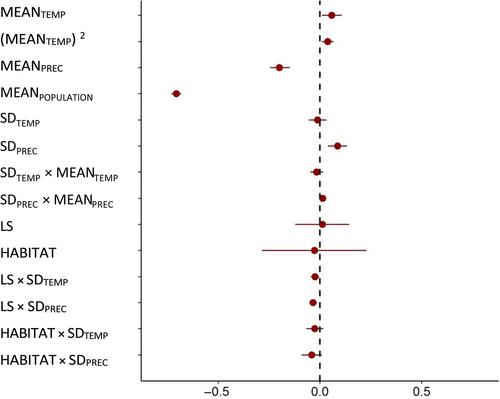Long-term climatic means affect the magnitude of short-term variability in population growth rates
Abstract
Aim
Temporal variability in population growth rates is a fundamental property of natural populations with implications for almost any facet in ecology and evolution. Using the framework of nonlinear averaging, we test the hypothesis that the magnitude of short-term variability in population growth rates is influenced by the long-term means of climatic conditions.
Location
The contiguous United States.
Time period
1970–2019.
Major taxa studied
Birds.
Methods
Our study encompassed 3941 populations of resident birds in 1335 localities across the contiguous United States. For each population, we quantified the standard deviation of annual growth rates over the relevant period and the corresponding long-term mean values of annual temperature and precipitation. We further considered the effects of covariates known to influence temporal variability in population growth, namely the standard deviations of climatic variables, the lifespan and the preferred habitat (forest vs. non-forest) of each species. The effects of climate and species traits on the variability in population growth rates were analysed using linear mixed-effects models.
Results
The magnitude of variability in population growth rate decreased with increasing the long-term mean of annual precipitation and had a U-shaped dependence on mean annual temperature. Variability in climatic conditions increased population growth variability, but this effect was weaker than the effect of the corresponding long-term means. A long lifespan reduced the impact of climatic variability on the variability in population growth rates.
Main conclusions
Our finding that the magnitude of variability in population growth rates is influenced by the long-term characteristics of climatic conditions and species traits extends our perspective on the relationship between climate and population dynamics and should be taken into account in future assessments of spatial and temporal population responses to climate change.


 求助内容:
求助内容: 应助结果提醒方式:
应助结果提醒方式:


